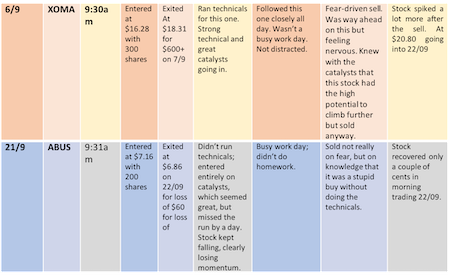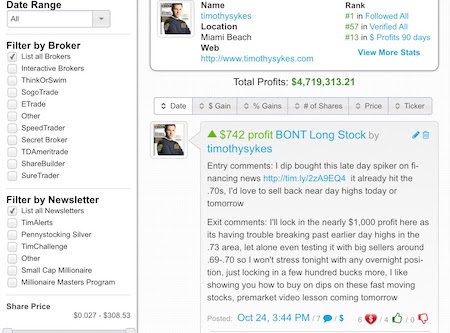| Trading Journal: What It Is and How to Create One in 2021
Recommended Link
Ready for Another March-Style Market Crash? 
This critical crash prep message is time-sensitive and controversial. It contains a mysterious crash preparation technique that you won’t find on Google, Bing, Youtube, or any other search engine or website. Please do NOT forward or share this opportunity with anyone else. Viewers discretion advised. | |

Dear Penny Stock Millionaire, Trading is a battlefield. Are you ready to fight for your account? A trading journal is one of the weapons that can help you stay alive in the trading game — and hopefully, thrive. We’re not talking “dear diary” here. A trading journal contains data that you can analyze and use to keep improving. Think tracking your trade data a waste of time? Big mistake. Consider this: when my top student, Tim Grittani, started trading, he blew up his small account. Then, he got serious about logging every trade. He analyzed his trading journal, figured out what setups were actually working, and focused on improving them. Did it work? Well, he’s now up $12 million+ in profits. Recently, he actually made $272K in a single day... A journal alone didn’t make Grittani millions. But it definitely didn’t hurt. Got your attention? Here’s everything you need to know about trading journals, including what they are, why they matter, and how to create an effective one. What’s a Trading Journal? A trading journal (aka trading diary) is where you track your daily progress as a day trader. Typically, entries will include details about your trades (or notes on why you didn’t trade), what you did, and your overall results. There’s more than one way to track your trading data. Some traders use a note-taking app, others use Excel or Google Docs. Some use a specific trading-related program. For instance, I keep track of my trading by logging every trade publicly on Profit.ly, complete with the ticker, date/time, entry and exit points, and commentary. Of course, I also take it further and keep track of my progress by recording videos and posting on social media to offer even more resources for my students. No matter the format, when it’s maintained meticulously, it can help make you a better trader. Benefits of a Stock Trading Journal A trading journal can help you understand yourself as a trader. Here’s how... A Trading Journal Will Help You Develop Your Strategies Maybe the most important benefit is that it can help you figure out which strategies work best for you. I talked earlier about Tim Grittani, who used his trading journal to figure out what strategies worked for him. Don’t miss the interview he did on the SteadyTrade Podcast, where he talks specifically about how he started using a journal to analyze his performance after initially blowing up his account. Know what he found? The setups that were actually working weren’t necessarily the ones he thought were working. Crazy how that works ... But once he realized which of his trades had the best success rate, he was able to zero in on these strategies and refine them. Paper trading, testing different strategies, and keeping a trading journal of your progress can help you figure out what strategies work best for you — and help you continue to improve over time. A Trading Journal Will Help You Develop Your Discipline in Trading Maintaining one forces you to face the truth about what you’re doing right — and what you’re doing wrong. When you’re honest about where you could improve, it can give your study time a sense of direction. It can also help improve discipline by creating a sense of accountability. For example, if you know that you’ll be posting your trades publicly on Profit.ly, you might be more likely to follow the rules... After all, it’s embarrassing to post trades over and over where you know you could have avoided a loss if you’d just followed the rules. A Trading Journal Will Help You Master Your Emotions It would be awesome if you could trade without emotions. Unfortunately, it’s not possible. That’s easy enough to see. Just look at all of the stubborn short-sellers and the bad decisions they make when they get caught in one of the insane short squeezes we’ve seen recently. Tracking your trades can help you start analyzing your own behavior patterns and figuring out what plays into your personal trading psychology. For instance, here’s an entry I wrote on Profit.ly about a trade where I had a $7 profit: Entry comments: “Buying this multi-week breakout that's been very annoying to trade so only a small position, but this could be the day it finally pops, goal is to make 10-20%, nothing huge as this one isn't usually very volatile but breakout is solid” Exit comments: “Tried to be patient but its just going nowhere, so I'm out for small profits, probably better for panic dip buying only as this one has always been frustrating lately” I know I can be impatient and make bad decisions when I get frustrated, so I got out fast. A Trading Journal Will Improve Your Risk Management Risk management just means considering all of the variables associated with a risk and assessing the level that you’re willing to take. Any time you trade, you’re taking a risk. You can’t change that. But you can work on how you manage it. Are you, like so many newbies, taking massive positions on trades, hoping you’ll win big? Start logging your trades. You might notice you have the wrong money mindset, and it’s making you lose big. Tracking it all can help you adjust your risk levels to a smarter level. It’s all about small wins adding up over time! I like to keep things tight — I cut losses quickly. That’s rule #1. Sometimes I take profits too quickly. But I’d rather make less and stay SAFE than hold and hope. Recommended Link
Prepare for America's Trojan Horse… 
The left’s plan to push America into a socialist nation is finally coming to fruition right before our eyes…
But what could happen “next” will have a tremendous impact on your everlasting wealth. | |
4 Top Trading Journal Tools #1 Profit.ly If you’re on Profit.ly, it’s easy to log trades. Just click on the “Post a Trade” button. From there, you’ll be guided to a form where you fill out basics like the ticker, a chart, entry and exit times and prices, your position size, whether you went long or short, and a ton of other details. You’ll also be given a space to make notes on the trade if you have any. This is where I publicly post every single trade. It’s great because it’s easy to share my trades and show them during webinars, and it also keeps track of open and closed trades, average profit, and other stats. #2 Note-Taking Apps There are a ton of note-taking apps you can use to track trades. A lot of them are supported by mobile devices and the web, making it easy to keep track of your trades. My friend and SteadyTrade Team lead trainer Tim Bohen from StocksToTrade is a big fan of Evernote, but there are a ton of different note-taking apps out there. They range from free basic versions to more advanced paid versions. So if you want things like email integration, file search, photo scanning, or the ability to add images or audio, you might want to opt for a paid version. #3 Excel A lot of traders just keep track of their trades in plain old spreadsheets. It makes sense — it’s simple, easy to add numbers and keep track of P&L, and it’s fast. The one problem with Excel is that it’s not really easy to take detailed notes and keep it easy to read. Some traders just deal with that annoyance. Others keep a separate document with more detailed notes and then keep track of the cold, hard numbers in Excel. #4 Pen and Paper I mean, you could always do it old school. Personally, I love my laptop too much. Honestly, I don’t even know if I can write with a pen anymore. I have blogger hands. But it works for some traders. How to Create an Efficient Stock Trading Journal Structure Your Trading Routine As I said in this tweet... 
… it’s all about boring old habits. Trading rewards consistency. Every trader has a routine that works for them ... Waking up early is a good start. That gives you time to run your scans, make a watchlist, and be prepared for the day ahead. No matter what your personal routine is, make sure that making entries in your journal is part of it. Analysis of the Market As a developing trader, you’re like a scientist conducting experiments. Your journal is where you keep your experiment notes. The more trades you track, the more data you amass. Then the more data you have, the more you have to learn from. And the more you learn, the more informed and prepared you’ll be. By recording your trades, market observations, and overall thoughts, you’re not just learning from your own mistakes and successes — you’re also learning how the stock market works. Analyze and Record Your Own Setups in Your Trading Journal Here’s how you can develop and refine your own setups using your journal... Find Setups to Trigger Your Entry You should go into every trade with a trading plan. But how do you figure out entry and exit points? To a certain degree, this is something you figure out over time. Tracking and analyzing trades can fast-forward your learning curve. By logging your entry and exit points over time, you’ll start to notice when you’re choosing good entry points. Market Insight Wanna become a pro at noticing market trends and how they affect your setups? Yep: trading journal. History repeats itself. For example, early on in the pandemic, we had a ton of spikers related to medical equipment. For smart traders who’d been logging trades for a while, that trend probably would have been evident. They could look back in their journal and see that the same exact thing happened during prior health scares with SARS and Ebola. So yeah, you could look at your journal as an easy resource for market insight over time. Determine Appropriate Lot Size Lot size is a fancy way of saying how many shares you buy in a single transaction. You don’t have to be aggressive in trading, and especially if you’re a new trader, it’s smarter to trade safe and small. Bigger isn’t always better with your position size. If you’re not consistent with small positions, you’re not going to magically make huge profits if you start taking massive positions. Focus on refining your strategy first. Keep track of your position sizes and how the trades work out. This can help you know when it’s time to start scaling up safely. Long/Short I used to do a lot of shorting, but I’ve changed my strategy based on the market. Now, I mainly go long. Don’t be loyal to a position — be loyal to what’s working. Whether you’re going long or short, you should have really strict criteria for every trade. I have seven indicators I use for every trade. Stop and Profit Placement When are you stopping out? And when are you taking profits? Are you doing it too soon, like I often do? Or are you holding on too long? Make notes in your trading journal and BE HONEST. Cut Losses Quickly The most important rule in all of trading: cut losses quickly. Yeah, I trade like a coward. But I’d rather take profits too quickly than hold too long and lose big. But I also cut losses quickly, and that keeps my losses small. Over time, I don't care about not missing the highest highs. I know that by trading scared I minimize losses. Stop Loss A stop loss is an order that you place where you sell a stock when it reaches a specific price. I don’t use stop orders. Instead, I stay in front of my computer during the trade and have a mental stop. But I also have the discipline to stick with it. But if that doesn’t work for you, you might want to have a stop in place. Read up on the basics of stop losses here and how you can use them to protect your account. Tracking that data can help you zero in on appropriate positions and find ideal stop losses. It can help you effectively implement mental stops too. Record the Profit or Loss from Each Trade in Your Trading Journal Every time you make a trade, make a detailed entry in your journal about the specifics, including the profit or loss from each trade. Recommended Link
Outsmart Wall Street's Top Options Traders 
It's no secret that the market has provided endless opportunities to generate extremely profitable trades this past quarter. Scott Bauer, a professional trader with 25+ years of experience has already been targeting numerous triple-digit wins like these this year alone... He’s actually put together a free guide that has 25 winning option strategies. | |
What Else Do You Need to Record In Your Trading Journal? As much as you think you’ll remember the details of your trading setup, you probably won’t. Record these things to make the most of every entry… Date Obviously, right? But sometimes traders forget this important detail. You want to be able to go back and look at the stock chart on that date if you need to. Time Frame Time-stamp your entry, too. In the world of day trading, minutes matter. It can make a big difference if you traded in the morning hours versus mid or late day. The same setup that spells success in the morning could be a massive midday flop. Price In What was your entry point for the trade? Why did you choose this level? Was there volume, volatility, a catalyst? Price Out When did you exit? Be sure to note any difficulties in getting out of your positions. It might affect how much you risk next time. The Amount You’re Risking Have an idea of your max pain point for any trade. For instance, if you’re in at $4.15 and you intend to cut losses if it goes down to $4.10, know that before you get into the trade. How much should you risk on a trade? My opinion is that you should always take a more cautious position. Never risk more than you could comfortably lose. You don’t want the stress of potentially blowing up your account on any trade. This might make you act or react in irrational, emotionally driven ways. Example of a Trading Journal Spreadsheet Here’s an example of what a trading journal spreadsheet might look like: 
And here’s an example of how I might log a trade on Profit.ly: 
These are just two examples of how a trading journal could look — but there aren’t specific rules for how you format yours. Tips for a Successful Trading Journal Want more tips to help you maximize your journal’s potential? Good. I have a few more for you… Identify Patterns That Lead to Your Losses Making trading mistakes is inevitable. I don’t win all of the time. My success rate is about 70%. You can see all my trades on Profit.ly — I’m a firm believer in full transparency. I never aim for slam-dunk trades. And I know that’s unattainable. While I can control my research, I can’t control what the market will do. What I can control is how I learn from my losses. If you track your trades well, you’ll eventually see patterns with your losses. It might be the time of day, a sector you can’t nail, or a flaw in your setup. Whatever it is, figure it out. Then work to make it better. Identify Patterns That Lead to Your Winners Don’t just focus on what you’re doing wrong — look at what’s going right, too. You can — and should — chart patterns in your trades to help you analyze what’s working. I call myself a glorified history teacher. Much of my success in trading is based on my ability to identify patterns. Once you begin to collect data, you can begin to evaluate what patterns really work for you. For example: Are you getting good results shorting supernovas? Are you consistently finding winners by keeping up with updates from the StocksToTrade Breaking News add-on? Use this information to trade smarter. Master Your Skills With Professional Assistance The data in your journal is only as good as what you do with it. That means it’s important to understand the mechanics of the stock market to make sense of your data. Take the time to learn key setups, trading basics, chart patterns, and how to execute orders. I’ve got a ton of FREE resources for you. Here are just four to start with: If you’re ready to take trading to the next level, consider applying for my... Frequently Asked Questions About Trading Journals What Should a Trading Journal Include? Most traders include entry and exit dates and times, price in and price out, trade position, and profit or loss. You can also include your trading thesis, your mindset, and other relevant notes about the market or your trade. How Do You Make a Trading Journal? There’s more than one way to make a trading journal. Common methods include programs like Profit.ly, note-taking apps, Excel spreadsheets, or even pen and paper. How Do You Record a Trade in a Journal? Open your journal and enter the vital details of your trade, like date, time, entry and exit points, position size, profit or loss, and notes on what was going on. Include why you made the trade, how you felt, and if you think you could have done things differently. What Is the Purpose of a Trading Journal? Use a journal to log your data and learn from it. Over time you’ll see trends emerge in your trades, like setups, sectors, or times of day that tend to work for you. This can help you refine your setups and focus on finding the most promising trades for your strategy. How Do You Make a Trading Journal in Excel? Start by creating different columns for different entries like the ticker, date/time, entry, exit, profit and loss, and notes about your mindset or the overall market. Then add data for every trade you make. Some traders use color-coding for wins, losses, or strategies. The Bottom Line You do want to keep improving, right? If so, you’ve gotta keep track of your trades in a trading journal. Whether your journal is a color-coded spreadsheet, logged trades on Profit.ly, or even an old-school composition book, the data you collect over time can be super informative. It can help you figure out what strategies work best for you and so you can refine them over time. Go ahead, prove me wrong. Keep a journal, analyze the data, and see if it doesn’t improve your results. I dare you! Do you keep a trading journal? What program and format do you follow? Tim Sykes
Editor, Penny Stock Millionaires P.S. You’re about to hear from two of the smartest financial minds on the planet. One man is America’s #1 personal finance author… The other is a former advisor to the Pentagon and the CIA… They both predicted the great recession in 2008… And now they’re coming together to issue a new urgent prediction… Something they call “The Great American Reset of 2020.” According to them, it will change America forever… And wipe out millions of unprepared citizens. Click here for all the details and the 5 steps they recommend you take now. |
Post a Comment
0Comments